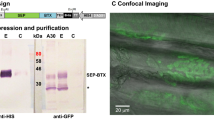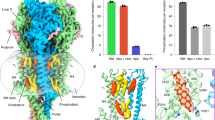Abstract
AFTER reviewing experimental results described in the literature, Acheson1 came to the conclusion in 1948 that the amount of acetylcholine liberated by a single impulse at a presynaptic nerve terminal in muscle and sympathetic ganglia is probably of the order of 1.5 × 10−16 gm. (10−18 moles). He pointed out the large discrepancy between this quantity and the relatively large amounts (3 × 10−14 moles) hitherto found necessary for excitation when applied directly to the muscle. This discrepancy has been much reduced in recent years by the electrophoretic application of acetylcholine from micropipettes3,7, and spikes have been produced in frog muscle fibres by this method with as little as 5.5 × 10−16 moles7. However, there still remained a substantial difference, and most of the potentials obtained by this method have not been strictly comparable with end-plate potentials elicited by nerve stimulation since they have a much slower time-course. For example, the quickest potential published by del Castillo and Katz3 rose to its maximum in 13 msec. These authors concluded that much faster potentials, and even greater sensitivity to acetylcholine, would be expected in the case of nervous release of acetylcholine, where the diffusion distance is less than 1µ ; in their experiments, the distance of the acetylcholine pipette from the end-plate was estimated to be 10–20µ(in a later paper4, they mention potentials with a rise time of 2–5 msec.).
This is a preview of subscription content, access via your institution
Access options
Subscribe to this journal
Receive 51 print issues and online access
$199.00 per year
only $3.90 per issue
Buy this article
- Purchase on Springer Link
- Instant access to full article PDF
Prices may be subject to local taxes which are calculated during checkout
Similar content being viewed by others
References
Acheson, G. H., Fed. Proc., 7, 447 (1948).
Cole, W. V., J. Comp. Neurol., 108, 445 (1957).
del Castillo, J., and Katz, B., J. Physiol., 128, 157 (1955).
del Castillo, J., and Katz, B., J. Physiol., 132, 630 (1956).
Krnjević, K., and Miledi, R., J. Physiol., 140, 440 (1958).
Krnjević, K., and Miledi, R., J. Physiol. (in the press).
Nastuk, W. L., Fed. Proc., 12, 102 (1953).
Author information
Authors and Affiliations
Rights and permissions
About this article
Cite this article
KRNJEVIĆ, K., MILEDI, R. Acetylcholine in Mammalian Neuromuscular Transmission. Nature 182, 805–806 (1958). https://doi.org/10.1038/182805b0
Issue Date:
DOI: https://doi.org/10.1038/182805b0
This article is cited by
-
An optimized acetylcholine sensor for monitoring in vivo cholinergic activity
Nature Methods (2020)
-
Determining the Neurotransmitter Concentration Profile at Active Synapses
Molecular Neurobiology (2009)
-
Nervous control of membrane conductance in mouse lacrimal acinar cells
Pfl�gers Archiv European Journal of Physiology (1984)
-
Bestimmung der Zahl aktiver Zentren der Acetylcholinesterase in motorischen Endplatten
Experientia (1965)
Comments
By submitting a comment you agree to abide by our Terms and Community Guidelines. If you find something abusive or that does not comply with our terms or guidelines please flag it as inappropriate.



